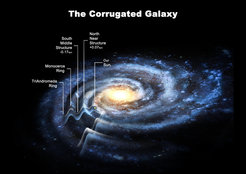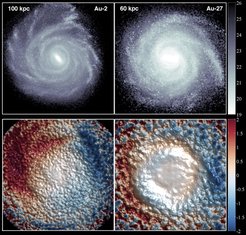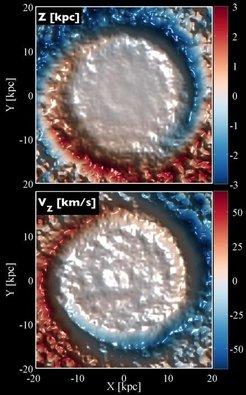Warps and waves in fully cosmological models of galactic discs

Large observational surveys of spiral galaxies have revealed that their stellar discs are often not flat but rather show a perturbed vertical structure. There is strong evidence that even our own Galactic disc has been significantly perturbed. The most common morphology for these vertical perturbations is what is known as an S-shaped or ‘integral sign’ warp which is frequently visible in edge-on galaxies. However, although less common, other types of distortion have also been observed. For example, rather than a flat plane, our Galactic disc presents a corrugated structure, resembling the pattern observed on a pond after dropping a rock (see Figure 1).
At least two major mechanisms are known to be capable of producing vertical perturbations of the otherwise flat outer discs of spirals. The first mechanism is tidal distortion of a pre-existing disc by an external perturber. The standard paradigm of hierarchical structure formation not only predicts that galaxies are surrounded by a non-spherical distribution of dark matter, but also that they grow in mass and evolve morphologically thanks to mergers with satellite galaxies. Strong tidal torques are exerted on a pre-existing disc as relatively massive satellites pass by and can induce the formation of vertical perturbations such as warps. In addition, a dark matter halo that is misaligned with respect to the embedded disc can also drive the formation of such vertical features. Another mechanism is misaligned accretion of cold gas. Such accretion can result from a close encounter with a gas-rich satellite or from misaligned infall from the cosmic web, or from a cooling hot gas halo.

This strong connection between stellar discs and the outer regions of galaxies indicates that it is possible to study unseen structure in galaxy halos by characterizing their disc's vertical structure. To date, however, it has not been established what is the dominant mechanism driving the observed vertical perturbations. Furthermore, the frequency with which corrugation patterns (such as those observed in the Milky Way disc) arise in a cosmological context has not been quantified. To shed light on this problem a team of scientists at MPA, together with external collaborators, have analyzed a suite of 17 state-of-the art fully-cosmological hydrodynamical simulations of the formation of disc galaxies. These simulations, known as the Auriga Project, include the main physical processes responsible for the formation and evolution of galaxies and self-consistently follow the evolution of gas, stars and dark matter over time. Overall, they are one of the best currently available simulation sets for studies of the formation of Milky Way sized galaxies.
This work shows that, at the present day, about 70% of the simulated galactic discs show strong vertical distortions, with amplitudes that can exceed 2 kpc – almost seven times the thickness of the disk. Half of these are typical ‘integral sign’ warps while the rest are corrugation patterns (see Figure 2). Such structures are thus predicted to be common.

The vertical perturbations have a variety of causes. The most common is encounters with satellite galaxies which can be effective from surprisingly large distances. In some cases, however, the disc’s vertical patterns are clearly driven by the accretion of misaligned cold gas from halo infall or from mergers. Tidally induced vertical patterns can be identified in both young and old disc stellar populations, whereas those originating from cold gas accretion are seen mainly in the younger populations.
The team also characterized the mean vertical motions that arise due to these patterns. They find that satellites can induce vertical velocities as large as 60 km/s, quite substantial when compared to the rotational velocity of Milky Way of 220 km/s (see Figure 3). Such perturbations should be easily detectable in nearly face-on galaxies from line-of-sight stellar or gas velocity fields obtained by integral field spectroscopy or radio interferometry. This may be the easiest way to study the vertical structure of galactic discs in nearby galaxies, providing a direct way to assess the frequency with which oscillating vertical patterns arise in the nearby universe.














